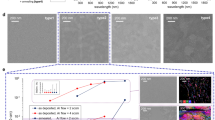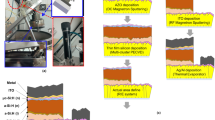Abstract
Transmittance and chromaticity are essential requirements for optical performance of thin-film transistor (TFT) arrays. However, it is still a challenge to get high transmittance and excellent chromaticity at the same time. In this paper, optimized optical design by using antireflection film theory and optical phase modulation is demonstrated in low temperature poly-silicon (LTPS) TFT arrays. To realize high transmittance, the refractive index difference of adjacent films is modified by using silicon oxynitride (SiOxNy) with adjustable refractive index. To realize excellent chromaticity, the thicknesses of multilayer films are precisely regulated for antireflection of certain wavelength light. The results show that the transmittance and chromaticity have been improved by about 6% and 18‰, respectively, at the same time, which is a big step forward for high optical performance of TFT arrays. The device characteristics of the TFT arrays with the optimal design, such as threshold voltage and electron mobility, are comparable to those of conventional TFT arrays. The optimized optical design results in enhanced power-conversion efficiencies and perfects the multilayer film design on the basic theory, which has great practicability to be applied in TFT arrays.
Similar content being viewed by others
References
Kim K H, Song J K. Technical evolution of liquid crystal displays. NPG Asia Materials, 2009, 1(1): 29–36
Schadt M, Helfrich W. Voltage-dependent optical activity of a twisted nematic liquid crystal. Applied Physics Letters, 1971, 18(4): 127–128
Ma J, Ye X, Jin B. Structure and application of polarizer film for thin-film-transistor liquid crystal displays. Displays, 2011, 32(2): 49–57
Jazi A Y, Yoon S, Liu J J. Automatic grading of TFT-LCD glass substrates using optimized support vector machines. Industrial & Engineering Chemistry Research, 2012, 51(33): 10887–10894
Hong Q, Wu T X, Zhu X Y, et al. Extraordinarily high-contrast and wide-view liquidcrystal displays. Applied Physics Letters, 2005, 86(12): 121107
Lyu J J, Sohn J, Kim H Y, et al. Recent trends on patterned vertical alignment (PVA) and fringe-field switching (FFS) liquid crystal displays for liquid crystal television applications. Journal of Display Technology, 2007, 3(4): 404–412
Lee S H, Lee S L, Kim H Y. Electro-optic characteristics and switching principle of a nematic liquid crystal cell controlled by fringe-field switching. Applied Physics Letters, 1998, 73(20): 2881–2883
Kim K H, Jeon E Y, Park B W, et al. Pixel electrode structure for high transmittance in a multi-domain vertical alignment liquid crystal display device. Journal of Physics D: Applied Physics, 2012, 45(6): 065103
Sawada M, Higuchi M, Kondo S, et al. Characteristics of indiumtin-oxide/silver/indiumtin-oxide sandwich films and their application to simple-matrix liquid-crystal displays. Japanese Journal of Applied Physics, 2001, 40(Part 1, No. 5A5R): 3332–3336
Jeong H S, Jeon H J, Kim Y H, et al. Bifunctional ITO layer with a high resolution, surface nano-pattern for alignment and switching of LCs in device applications. NPG Asia Materials, 2012, 4(2): e7
Nowak R E, Vehse M, Sergeev O, et al. ZnO nanorods with broadband antireflective properties for improved light management in silicon thin-film solar cells. Advanced Optical Materials, 2014, 2(1): 94–99
Mao S, Cui Q. Optimal design method for multi-layer diffractive optical elements with consideration of antireflection coatings. Journal of Modern Optics, 2018, 65(13): 1554–1558
Zhao J, Gao B, Li H, et al. Biomimetic plasmonic color generated by the single-layer coaxial honeycomb nanostructure arrays. Journal of Nanophotonics, 2017, 11(3): 036020
Dupuis J, Fourmond E, Lelièvre J F, et al. Impact of PECVD SiON stoichiometry and post-annealing on the silicon surface passivation. Thin Solid Films, 2008, 516(20): 6954–6958
Hussein M G, Wörhoff K, Sengo G, et al. Optimization of plasma-enhanced chemical vapor deposition silicon oxynitride layers for integrated optics applications. Thin Solid Films, 2007, 515(7–8): 3779–3786
Alayo M I, Pereyra I, Scopel W L, et al. On the nitrogen and oxygen incorporation in plasma-enhanced chemical vapor deposition (PECVD) SiOxNy films. Thin Solid Films, 2002, 402(1–2): 154–161
Afanasyev-Charkin I V, Jacobsohn L G, Averitt R D, et al. Amorphous silicon nitride films of different composition deposited at room temperature by pulsed glow discharge plasma immersion ion implantation and deposition. Journal of Vacuum Science & Technology A: Vacuum, Surfaces, and Films, 2004, 22(6): 2342–2346
Bustarret E, Bensouda M, Habrard M C, et al. Configurational statistics in a-SixNyHz alloys: A quantitative bonding analysis. Physical Review B, 1988, 38(12): 8171–8184
Ay F, Aydinli A. Comparative investigation of hydrogen bonding in silicon based PECVD grown dielectrics for optical waveguides. Optical Materials, 2004, 26(1): 33–46
Acknowledgements
This work was supported by the Shenzhen Science and Technology Innovation (Grant No. JCYJ20180507181702150), the Guangdong Science and Technology Plan Project (Grant No. 2019A050510011), and the National Natural Science Foundation of China (Grant No. 61504004).
Author information
Authors and Affiliations
Corresponding authors
Rights and permissions
About this article
Cite this article
Luo, C., Long, S., Liu, G. et al. Optimized optical design of thin-film transistor arrays for high transmittance and excellent chromaticity. Front. Mater. Sci. 14, 89–95 (2020). https://doi.org/10.1007/s11706-020-0493-9
Received:
Accepted:
Published:
Issue Date:
DOI: https://doi.org/10.1007/s11706-020-0493-9




